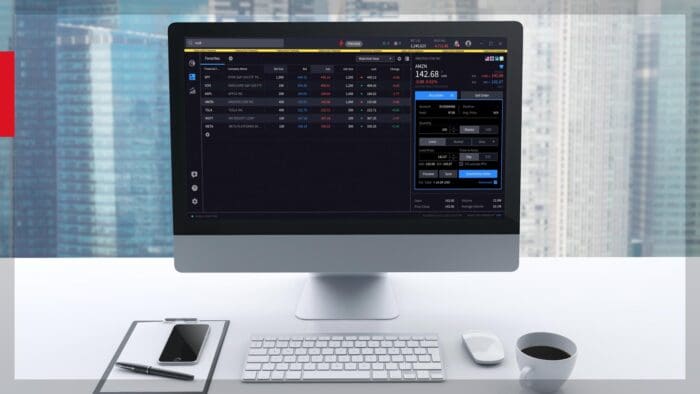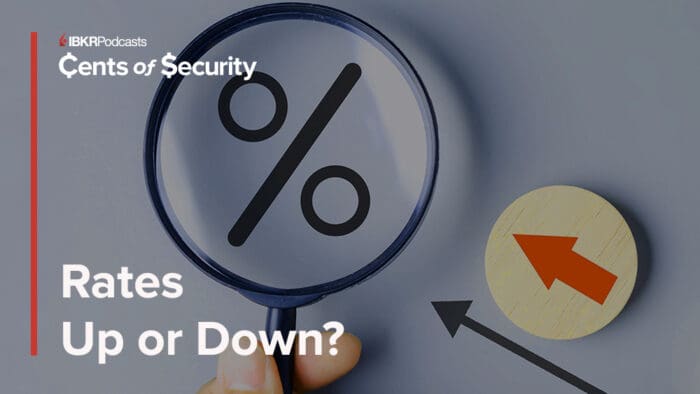Earnings season can spark sharp moves—but how much of it is predictable? Dmitry Pargamanik of Market Chameleon joins us to explore how traders can use historical options data to spot patterns, dodge outliers, and navigate the volatility around earnings announcements.
Summary – IBKR Podcasts Ep. 268
The following is a summary of a live audio recording and may contain errors in spelling or grammar. Although IBKR has edited for clarity no material changes have been made.
Jeff Praissman
Hi everyone, this is Jeff Praissman with IBKR Podcasts. It’s my pleasure to welcome back to our studio Dmitry Pargamanik from Market Chameleon.
Dmitry Pargamanik
Hey Jeff. How are you doing?
Jeff Praissman
We just got done a great webinar on earnings screenings through option activity, and we have the opportunity, as we do every month, to take a deeper dive into it—having you in the podcast studio. So I’m excited. And, you know, we probably should just start with the obvious question, right? So why analyze historical option strategies around earnings? What is the benefit?
Dmitry Pargamanik
When we look at earnings, options are a unique instrument that allows you to either hedge or make an outlook on a binary event. And earnings are binary events. They come once a quarter, so you got them usually four times a year. Around earnings, the stock and the options behave differently—especially because you have this earnings announcement. After the earnings announcement, right before that, you have this high uncertainty. Then you get this news, and the stock can reprice very quickly and move to a new level. And that itself is different than how a stock would behave from day to day when you don’t have earnings announcements. So just isolating those specific earnings dates and earnings announcements and analyzing them on their own is important, and it gives you a different opportunity to use options around that binary event.
Jeff Praissman
So what key metrics should traders prioritize when they’re analyzing historical option strategy performance during earnings seasons? Also, why are they crucial for informed decision-making?
Dmitry Pargamanik
Yeah. And there are different metrics available depending on what question you’re trying to answer. But typically around earnings, the most important—or the most frequently looked-at—metrics would be stock price movements, the volatility, or the gaps. How much volatility does this stock experience even heading into earnings? Is there an uptick in volatility maybe a day or two before the earnings? What type of volatility or gaps do we typically see? After the stock closes, usually the stock closes, you see an earnings announcement after that market closes or before the market opens, and then you get this gap move. And the volatility—right after the market opens—you’re going to see some more volatility, more than usual, because you’ve got this repricing going on. And you also have repricing of options. And how long does it take to get to those normal levels? So these are metrics you look at in isolation, maybe depending on what question you want to answer. But you’ll typically see metrics on volatility, stock price movements, the magnitude of the moves, and the premiums in the options. How do premiums behave going into earnings and coming out?
Jeff Praissman
And are the metrics able to indicate a bullish or bearish positioning?
Dmitry Pargamanik
The positioning itself would depend on the actual strategy of the option. So if you’re looking at a bullish positioning, you would do something like buying a call or a call spread or some kind of strategy that has a bullish outlook. Or you could have a bear outlook with options, and you could also have a direction-neutral strategy—something that is looking at a movement in either direction, such as a straddle. You’re looking at the magnitude of the move, either up or down. So that really is more based on the way you strategize with options.
Jeff Praissman
And how do the historical screening tools help identify optimal entry points for option strategies relative to earning dates?
Dmitry Pargamanik
Yeah. So when we look at the option strategies, a lot of people typically think of right before earnings and right after. But the options can behave—and the stock can behave—differently even leading up to earnings. It doesn’t have to be right before. You could have a strategy that avoids earnings completely, but you could do something like three days before earnings and right up to the end, right before the close before the announcement, or coming out of the earnings. And that’s important because even though you have this earnings event, you may want to take a look at how these strategies line up and what your potential risks and rewards are around those—or anchored around that earnings. Is there a potential there, or an opportunity even heading into earnings? Because maybe there’s lower volatility in the options and the stock, and they’re lined up well. Or do you go and hold a strategy all the way through the event, or wait until the event is over? And maybe there’s a strategy there where the options take longer to trade back into their usual implied volatility—or is it overdone? These are things that you could start looking at for different timeframes.
Jeff Praissman
And what indicators suggest the best timing for strategy implementation?
Dmitry Pargamanik
Yeah. And that would—obviously, we can’t time—but from a historical perspective, we could take a look at it. Sometimes you may see where a bullish strategy—even from a historical perspective—might have been better off waiting for the release and then putting on a bullish strategy. Because there’ll be a repricing, and then you see this flow coming in—or maybe heading into earnings. And these are from a historical perspective. Obviously, we don’t know—that doesn’t give you any guarantees for future results—but these are some things that you could go back in history and kind of take a look at and see. Given a strategy and its volatility, right? The risk—and make a decision based off that trade-off.
Jeff Praissman
Let’s talk about implied volatility for a second. How does implied volatility typically behave in the weeks leading up to earnings announcements, and what sort of strategies can benefit from that pattern that you would see in a screening tool?
Dmitry Pargamanik
Yeah. If we take the—let’s say—the option pricing model, the Black-Scholes, what you’ll see is when calculating the implied volatility, the implied volatility looks like it’s increasing heading into earnings. And then, after the earnings announcement, you’ll see a big drop because it’s heading right back to where it typically would be priced without an earnings event. So that’s something that you would observe. And the reason behind that is also that options have a component for this gap, right? Heading into earnings, what you’ll see is that there’s high uncertainty, so you’re going to have this component in there that is going to be priced in until the end of earnings. As you get closer, it looks like the implied volatility is moving higher. And it’s important then to look at the premium of the options compared to that expected move. From that perspective, when we look at implied volatility, traders have to keep in mind that the options themselves aren’t just pricing in average daily volatility from now to expiration. They have this one component in there that is looking at a specific event that will get taken out after that event—after the announcement of that event—and the stock gets repriced.
Jeff Praissman
Historical data’s never perfect, right? If it was, we’d all be super rich and not have to worry about anything. There are definitely outliers and other issues that pop into it. How can traders distinguish between the statistically significant patterns and these random one-off occurrences that, I think it’s safe to say, appear for many stocks—if not all—if you go back far enough?
Dmitry Pargamanik
Yeah, yeah. It’s a good question. How do we look for outliers or something that may skew the data, let’s say. And that’s very important too, because if you look at it—let’s just say, for example—we’re looking at an average movement of a stock after it reports earnings, and we get this average movement of, say, 10% up or down. But if we look at that data and we have this really big move—one of those earnings moved up 25%—that will obviously skew our averages higher.
And if we look at that data point, it could be an outlier. It could be something where something special happened in that earnings. Let’s just say we go back and we find out that in that particular earnings event, they announced the results of a lawsuit that was going on for two years. That’s an outlier. We could say that doesn’t happen every quarter, right? We can’t expect a movement like that, and you might want to remove that from your data set. You might get a much different metric—maybe not a 10% average, but a 5%.
So it’s something to really keep in mind, yes, when you’re looking at the data sets and you’re running your analytics, and you’re trying to establish some kind of a modeling around your potential opportunities, potential returns, or certain potential risk. Looking for those outliers becomes important, and you definitely want to take those into account—if there’s an outlier and you can explain it away based on something like we just discussed.
Jeff Praissman
And how can traders balance win frequency versus the average return versus best-case/worst-case scenarios in evaluating these historical options strategies when they’re taking a look at it?
Dmitry Pargamanik
Yeah, and when we run these statistics and metrics, they work together in some sense, and they answer different questions. Like, when we mention win rate, we want to see how often something happens, right? The frequency of something happening. How often does the stock move beyond 10%? How often does the stock gap up or gap down historically?
So that’s just looking at the historical frequency of something happening. And then we could look at the average returns, best-case/worst-case scenario—that’s looking at the magnitude of the moves. That’s looking at what kind of potential movements we can get—ranges—from a historical perspective. Because we don’t know the future, of course, but using a model, we plug in the data that’s available so we can model out the potential movements from zero to wherever.
So these are things that are important—they answer different questions and work together.
Jeff Praissman
And time premium is such an important part of option pricing. What role does time decay play in the profitability of options strategies during earnings—particularly when you’re looking at implementing different positions at different distances from the announcement date?
Dmitry Pargamanik
Yeah, and that’s a good question because when you have an option that, let’s say, covers earnings, you’re going to have that component for the gap that’s not going to decay until that announcement. So you’re not going to see a typical decay in that option. If we plug it into the option pricing model, we’re going to get this theta number. And the theta number doesn’t really reflect a component for a binary event—it just says that this is going to decay X amount every day, or whatever, on the day.
So when we look at time decay that involves an option with a binary event like earnings, it’s not going to decay the same way as an option that doesn’t have that component. And so when we look at that theta number, it’s not the same until you take that component out. So if you’re looking at strategies, having that in mind—you have to take that into account.
Jeff Praissman
And Dmitry, could you discuss the process of validating a strategy’s effectiveness across multiple earnings cycles? What statistical measures should traders use to confirm whether these observed patterns are meaningful—or if it’s just a big coincidence, like you’re just looking at the last couple earnings and it just happened to go this way?
Dmitry Pargamanik
Yeah. So when we look at a strategy—for example, an option strategy—what we try to do is look at the market price of the strategy, right? Because the market price of the strategy reveals something. It reveals to us what the market thinks: the likelihood of something happening and what the payoff potential could be.
So we look at that from that perspective, and then we try to analyze it and compare it to what we believe it could be. And when we look at it, it’s not really about the effectiveness of it, but what we believe the pricing of the strategy is at this point—does it offer some type of opportunity relative to what we believe?
So I’ll give you an analogy. If I’m looking at the outcome of a football game, and I have no idea if Team A or Team B will win, and I’m assuming there’s an equal chance of either team becoming the winner of this football game—or soccer game, whatever—and what I observe is that somebody is handicapping one of them. They’re giving you five points, or ten points, or something. Then that could be an opportunity, because that would indicate there’s a good risk-reward in the market at this point.
So the markets are always pricing and repricing. What you’re looking at is: how is it priced, what is it indicating, and how does that compare to my particular outlook or payoff?
Jeff Praissman
Dmitry, this has been great. Are there any final thoughts you’d like to leave our listeners with?
Dmitry Pargamanik
Yeah, I think that with options trading, a lot of people use options to trade earnings, because we do see a big boost in volume typically around earnings. And to use those historical levels—or historical data—and even a screener like the one we were discussing, can help with your analysis, your opportunities, your potential risks and rewards going into those potential positions. So just something traders should be considering if they’re about to take an options position around earnings.
Jeff Praissman
Again, thanks for coming by. For our listeners, you can find more from Market Chameleon on our website under Education. You can find webinars, articles they’ve written, podcasts—they also run a morning show every day, Monday through Friday, on YouTube. And again, always love you coming in once a month to discuss everything options.
Until next time, I’m Jeff Praissman with Interactive Brokers.
Disclosure: Interactive Brokers
The analysis in this material is provided for information only and is not and should not be construed as an offer to sell or the solicitation of an offer to buy any security. To the extent that this material discusses general market activity, industry or sector trends or other broad-based economic or political conditions, it should not be construed as research or investment advice. To the extent that it includes references to specific securities, commodities, currencies, or other instruments, those references do not constitute a recommendation by IBKR to buy, sell or hold such investments. This material does not and is not intended to take into account the particular financial conditions, investment objectives or requirements of individual customers. Before acting on this material, you should consider whether it is suitable for your particular circumstances and, as necessary, seek professional advice.
The views and opinions expressed herein are those of the author and do not necessarily reflect the views of Interactive Brokers, its affiliates, or its employees.
Disclosure: Market Chameleon
The information provided on MarketChameleon is for educational and informational purposes only. It should not be considered as financial or investment advice. Trading and investing in financial markets involve risks, and individuals should carefully consider their own financial situation and consult with a professional advisor before making any investment decisions. MarketChameleon does not guarantee the accuracy, completeness, or reliability of the information provided, and users acknowledge that any reliance on such information is at their own risk. MarketChameleon is not responsible for any losses or damages resulting from the use of the platform or the information provided therein. The 7-day free trial is offered for evaluation purposes only, and users are under no obligation to continue using the service after the trial period.
Disclosure: Options Trading
Options involve risk and are not suitable for all investors. For information on the uses and risks of options, you can obtain a copy of the Options Clearing Corporation risk disclosure document titled Characteristics and Risks of Standardized Options by going to the following link ibkr.com/occ. Multiple leg strategies, including spreads, will incur multiple transaction costs.


















Join The Conversation
For specific platform feedback and suggestions, please submit it directly to our team using these instructions.
If you have an account-specific question or concern, please reach out to Client Services.
We encourage you to look through our FAQs before posting. Your question may already be covered!